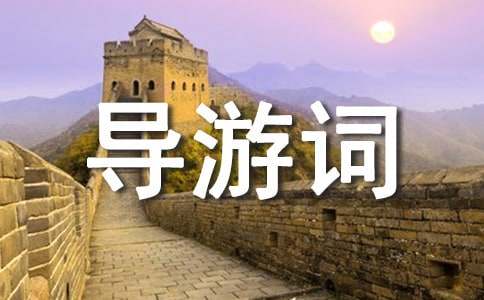宝墨园英文导游词范文
Baomo Garden is located at Zini Village, Panyu, Guangzhou. It was first built in the late Qing Dynasty (1644-1911), ruined in 1957, and reconstructed in 1995. Now it covers an area of more than 66600 square meters, and is a masterpiece of South China gardens and architectures. The garden, laid out properly, is crisscrossed with streams and more than 30 stone bridges. Finely made artistic works including pottery sculptures, clay figurines, stone carvings, brick carvings, wood carvings, etc. decorate the whole garden. In the exhibition halls you can appreciate a large quantity of antiques, and calligraphy and paintings by celebrated masters.

This memorial arch is built with over 400 pieces of granite and weighs over 600 tons. The three characters on it – Bao Mo Garden – were written by Qigong, a famous calligrapher. On the crossbeams were carved images of beasts that symbolize luck and pictures that depict ancient Chinese folk tales. The couplet on the two sides means that at Zini Village treasures are collected; in Baomo Garden the scenery of the south is presented.
This granite bridge is known as Nine-dragon Bridge. It’s an imitation of the Jinshui Bridge in front of Tian’anmen in Beijing. On a 7m long and 3m wide slate on the bridge are carved nine lifelike dragons. The name Nine-dragon carved on the bridge is a copy of calligraphy by Zhao Ji, a Song Dynasty (960-1279) Emperor.
The wall at the entrance, built with over 30,000 dark bricks, is a “screen wall”. Its function is to avoid exposure of the scenes in the garden. On its faade are carved more than 600 birds, insects as well as flowers and trees – phoenix, pheasant, dragonfly, pine, bamboo, willow and peony, to name just a few. The carvings stand for vitality and prosperity. On the reverse side are carvings of calligraphy by Wang Xizhi, a best-known calligrapher of the Jin Dynasty (265-420). This gigantic masterpiece of traditional South China brick carving was designed and created by a young artist, He Shiliang by name.
This hall was built in honor of Bao Gong, an official of the Northern Song (960-1127) who was known and held in high esteem for being upright, incorruptible, straight and fair. The name of the hall was after a poem by him, “The foundation of ruling a country is officials being incorruptible and upright.”
At the central place of the hall is hanged a Chinese painting “Lotus Flower”, symbolizing Bao’s noble spirits. The couplet by its sides means that Bao was an upright and incorruptible official; his deeds would pass on and always be held in esteem.
On the right side of the hall there is a wooden tablet with the Chinese characters “Baomo Garden” inscribed on it. It’s made of wood unearthed from a Western Han (206 BC -25 AD) tomb. At the back of the hall there is a granite tablet also with the inscriptions “Baomo Garden”, which is the only remnant of the original garden.
The two halls were also built in honor of Bao Gong. At the central place of Baomo Hall is hanged a portrait of Bao clothed in red official robes, a figure of uprightness. In stories, legends and dramas, Bao was presented as dark-skinned. This is, in fact, an artistic image, because dark skin stands for somberness, uprightness and straightness. The couplet also praises Bao as a recommendable official who was held in everlasting esteem.
The corridor in Baomo Garden is constructed in traditional Chinese way; supported by wooden crossbeam and columns as well as dougong (brackets ed between the top of a column and a crossbeam), and covered by arched dark tiles. The corridor, more than 1300 meters long, links the pavilions, terraces, storied buildings, and pools, which not only makes it convenient for the visitors but also serves as a good place for resting and sightseeing.
The arch is located at the very center of the Garden. It is built with white stone. The pedestal is embedded with twelve animals representing the Chinese lunar years and images of the Eight Immortals in Daoism, all in granite. In front of the Arch there stand a pair of stone lions, at the back a pair of legendary auspicious beasts – kylin. This arch symbolizes the nobility of incorruptible officials.
Zidai Bridge is a nine-arch white stone bridge. It spans the Qingping Lake, and looks like a beautiful rainbow over the waves. The bridge presents a picturesque view when seen from afar. The over 30 stone sculptures by the railings are about stories from historical novels. The fine sculpture makes them masterpieces.
Zidong Boat is a characteristic of those in the Pearl River Delta: luxurious decoration, tables set at the bow, and kitchen at the stern. This kind of pleasure-boats were most popular during the Ming and Qing dynasties, originally owned by the rich, and later developed into tea houses on the river.
This is a large-scale mural of porcelain sculpture modeled after an invaluable painting by Zhang Zeduan, a master painter of the Northern Song Dynasty (960-1127). The mural is 63m long and 7m wide, 100 times the size of the painting. It gives detailed description to the prosperous scene in Bianliang, capital of Northern Song (which is now known as Kaifeng, located in Henan Province). 1648 figures can be counted on it. It’s a record of the city life back then and a reflection of prosperous trade in China.
This is a place for the collection of cultural relics and antiques. On the first story are collected porcelains across different dynasties, and on the second story, calligraphy and paintings by famous figures of all times.
【宝墨园英文导游词】相关文章:
游广州宝墨园散文06-13
宝墨园的快乐抓鱼-作文05-19
秋游宝墨园作文500字03-22
描写宝墨园的作文(通用25篇)09-19
球墨的英文及例句09-25
宝峰湖导游词03-09
七宝老街导游词03-10
英文导游词09-03
导游词 英文01-27